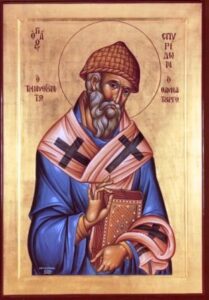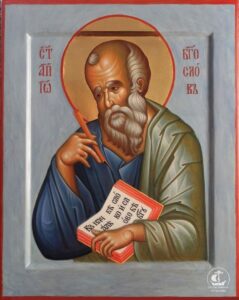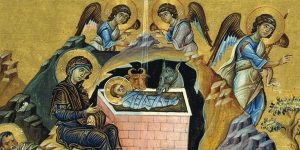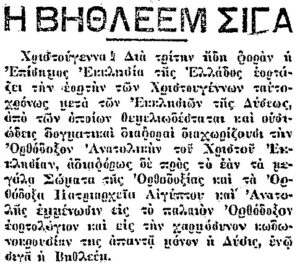St. Cedd Bishop of East Saxons – October 26
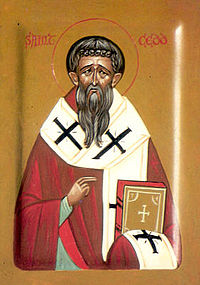
St. Cedd (Latin: Cedda, Ceddus; c. 620 – 26 October 664) was an Anglo-Saxon monk and bishop from the Kingdom of Northumbria. He was an evangelist of the Middle Angles and East Saxons in England and a significant participant in the Synod of Whitby, a meeting which resolved important differences within the Church in England. St.
The little that is known about St. Cedd comes to us mainly from the writing of St. Bede in his Ecclesiastical History of the English People. The following account is based entirely on Book 3 of Bede’s History.
Cedd was born in the kingdom of Northumbria and brought up on the island of Lindisfarne by St. Aidan of the Irish Church. He had three brothers: St. Chad of Mercia (transcribed into Bede’s Latin text as Ceadda), Cynibil and Cælin). All four were priests and both Cedd and Chad became bishops. The first datable reference to Cedd by Bede makes clear that he was a priest by the year 653. This probably pushes his birth date back to the early 620s. It is likely that Cedd was oldest of the brothers and was acknowledged the head of the family. He seems to have taken the lead, while Chad was his chosen successor.
St. Cedd is not mentioned as one of the wandering scholars. He is portrayed by St. Bede as very close to Aidan’s successor, Finan. So it is highly likely that he owed his entire formation as a priest and scholar to Aidan and to Lindisfarne.
In 653, St. Cedd was sent by Oswiu of Northumberland with three other priests to evangelise the Middle Angles, who were one of the core ethnic groups of Mercia, based on the mid-Trent Valley. Peada of Mercia, son of Penda, was sub-king of the Middle Angles. Peada had agreed to become a Christian in return for the hand of Oswiu’s daughter, Alchflaed (c.635-c.714) in marriage. This was a time of growing Northumbrian power, as Oswiu reunited and consolidated the Northumbrian kingdom after its earlier (641/2) defeat by Penda. Peada travelled to Northumbria to negotiate his marriage and baptism.
St. Cedd, together with the priests, Adda, Betti and Diuma, accompanied Peada back to Middle Anglia, where they won numerous converts of all classes. Bede relates that the pagan Penda did not obstruct preaching even among his subjects in Mercia proper, and portrays him as generally sympathetic to Christianity at this point – a very different view from the general estimate of Penda as a devoted pagan. But, the mission apparently made little headway in the wider Mercian polity. Bede credits Cedd’s brother Chad with the effective evangelization of Mercia more than a decade later. To make progress among the general population, Christianity appeared to need positive royal backing, including grants of land for monasteries, rather than a benign attitude from leaders.
St. Cedd was soon recalled from the mission to Mercia by Oswiu, who sent him on a mission with one other priest to the East Saxon kingdom. The priests had been requested by Sigeberht the Good to reconvert his people.
St. Bede tells us that Sigeberht’s decision to be baptized and to reconvert his kingdom was at the initiative of Oswiu. Sigeberht traveled to Northumbria to accept baptism from Bishop Finan of Lindisfarne. St. Cedd went to the East Saxons partly as an emissary of the Northumbrian monarchy. Certainly, his prospects were helped by the continuing military and political success of Northumbria, especially the final defeat of Penda in 655. Practically, Northumbria gained hegemony among the Anglo-Saxon kingdoms.
After making some conversions, Cedd returned to Lindisfarne to report to Finan. In recognition of his success, Finan ordained him bishop, calling in two other Irish bishops to assist at the rite. Cedd was appointed bishop of the East Saxons. As a result, he is generally listed among the bishops of London, a part of the East Saxon kingdom. Bede, however, generally uses ethnic descriptions for episcopal responsibilities when dealing with the generation of Cedd and Chad.
St. Bede’s record makes clear that Cedd demanded personal commitment and that he was unafraid to confront the powerful. He excommunicated a thegn who was in an unlawful marriage and forbade Christians to accept the man’s hospitality. According to St. Bede, when Sigeberht continued to visit the man’s home, Cedd went to the house to denounce the king, foretelling that he would die in that house. Bede asserts that the King’s subsequent murder (660) was his penance for defying St. Cedd’s injunction.
After the death of Sigeberht, there were signs that St. Cedd had a more precarious position. The new king, Swithhelm of Essex, who had assassinated Sigeberht, was a pagan. He had long been a client of Æthelwold of East Anglia, who was increasingly dependent on Wulfhere of Mercia, the Christian king of a newly resurgent Mercia. After some persuasion from Ethelwald, Swithelm accepted baptism from St. Cedd. The bishop traveled into East Anglia to baptize the king at Ethelwald’s home. For a time, the East Saxon kingdom remained Christian.
Bede presents Cedd’s work as decisive in the conversion of the East Saxons, although it was preceded by other missionaries, and eventually followed by a revival of paganism. Despite the substantial work, the future suggested that all could be undone.
St. Cedd founded many churches.
St. Cedd was appointed as abbot of the monastery of Lastingham in his native Northumbria at the request of the sub-king Œthelwald of Deira. St. Bede records the foundation of this monastery in some detail, showing that Ethelwald was put in contact with Cedd through Caelin, one of the bishop’s brothers, who was on the king’s staff. Cedd undertook a 40-day fast to purify the site, although urgent royal business took him away after 30 days, and Cynibil took over the fast for him.
St. Cedd occupied the position of abbot of Lastingham to the end of his life while maintaining his position as missionary bishop and diplomat. He often traveled far from the monastery in fulfillment of these other duties. His brother Chad, who succeeded him as abbot, did the same. Cedd and his brothers regarded Lastingham as a monastic base, providing intellectual and spiritual support, and a place of retreat. Cedd delegated daily care of Lastingham to other priests, and it is likely that Chad operated similarly.
A short time later, he returned to Northumbria and the monastery at Lastingham. He fell ill with the plague and died on 26 October 664. St. Bede records that immediately after Cedd’s death a party of thirty monks traveled up from Essex to Lastingham to do homage. All but one small boy died there, also of the plague. St. Cedd was initially buried at Lastingham in a grave. Later, when a stone church was built, his body was moved and re-interred in a shrine inside the church of the monastery. Chad succeeded his brother as abbot at Lastingham.

